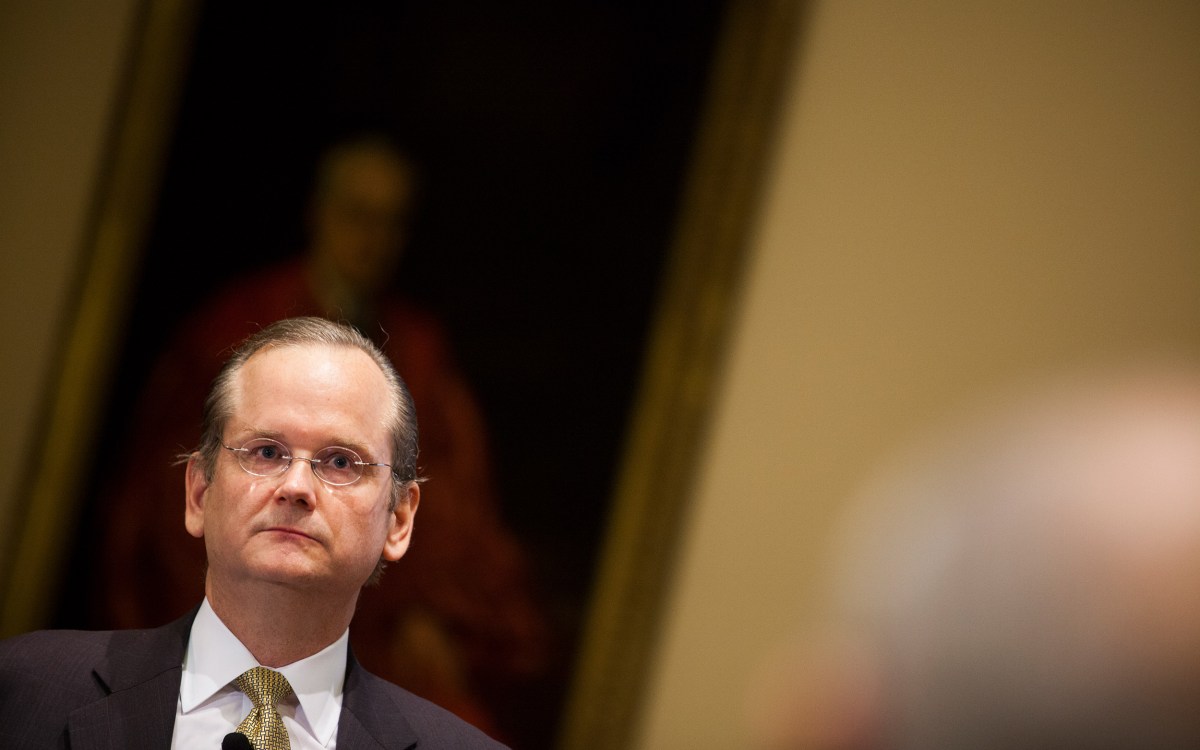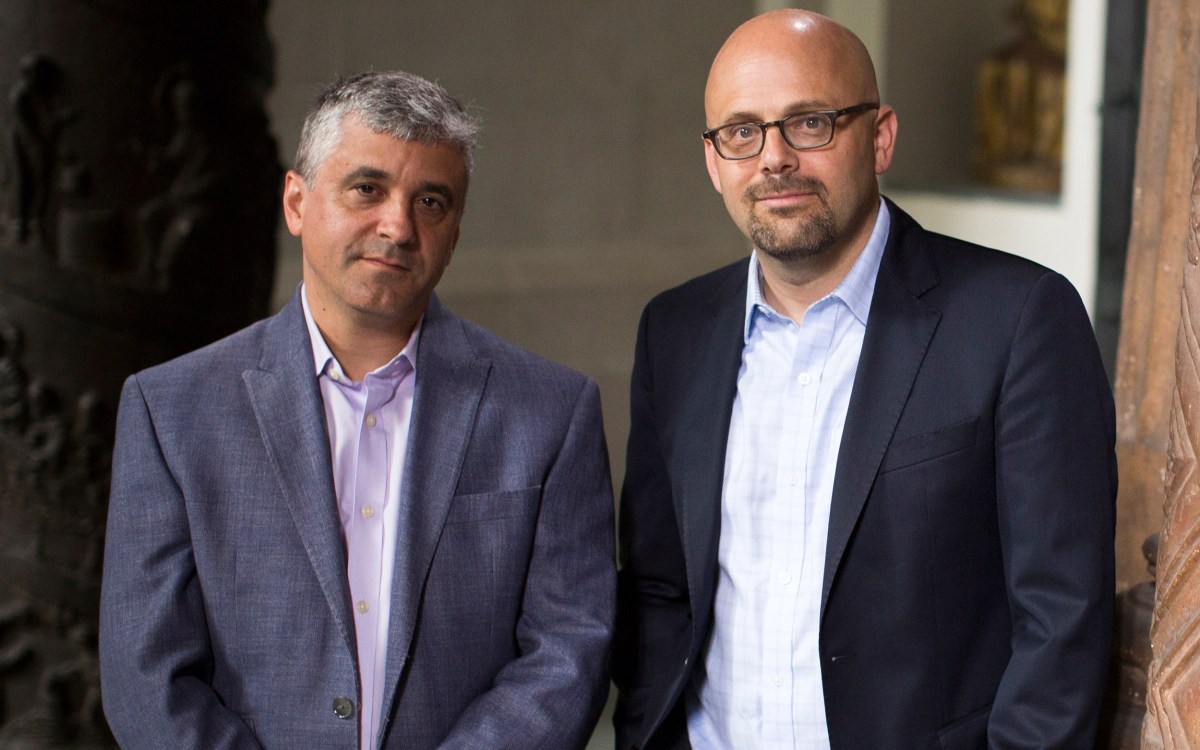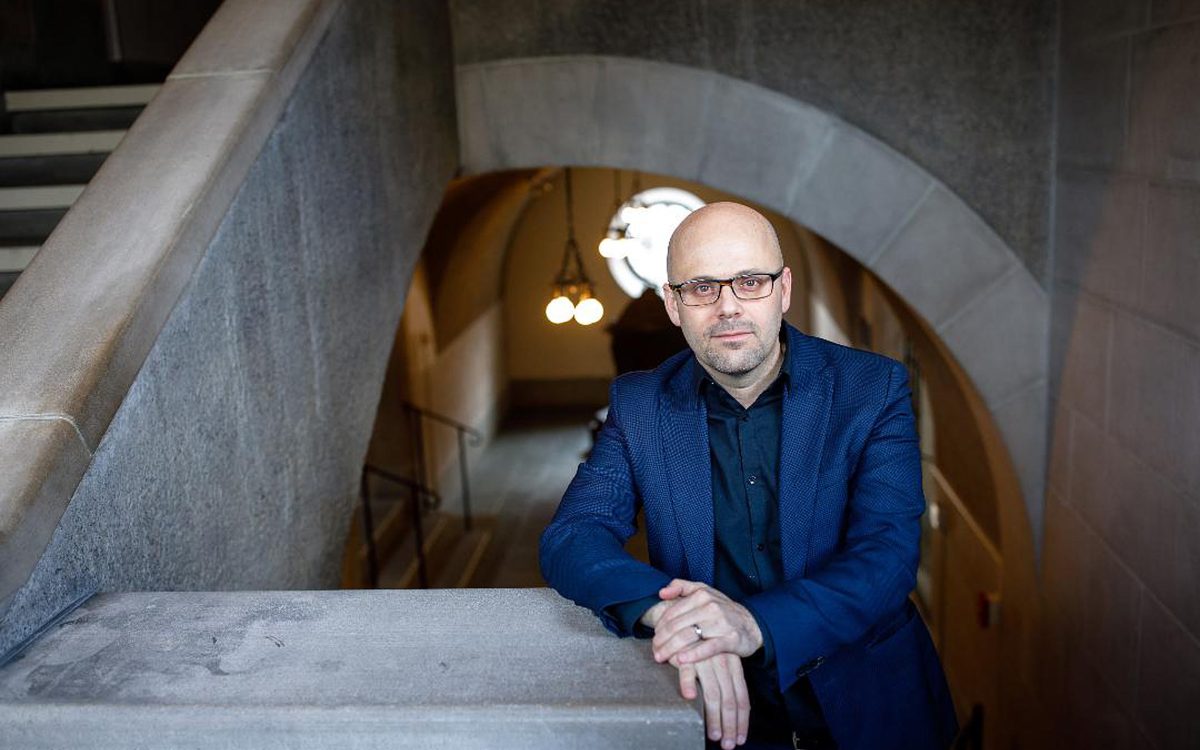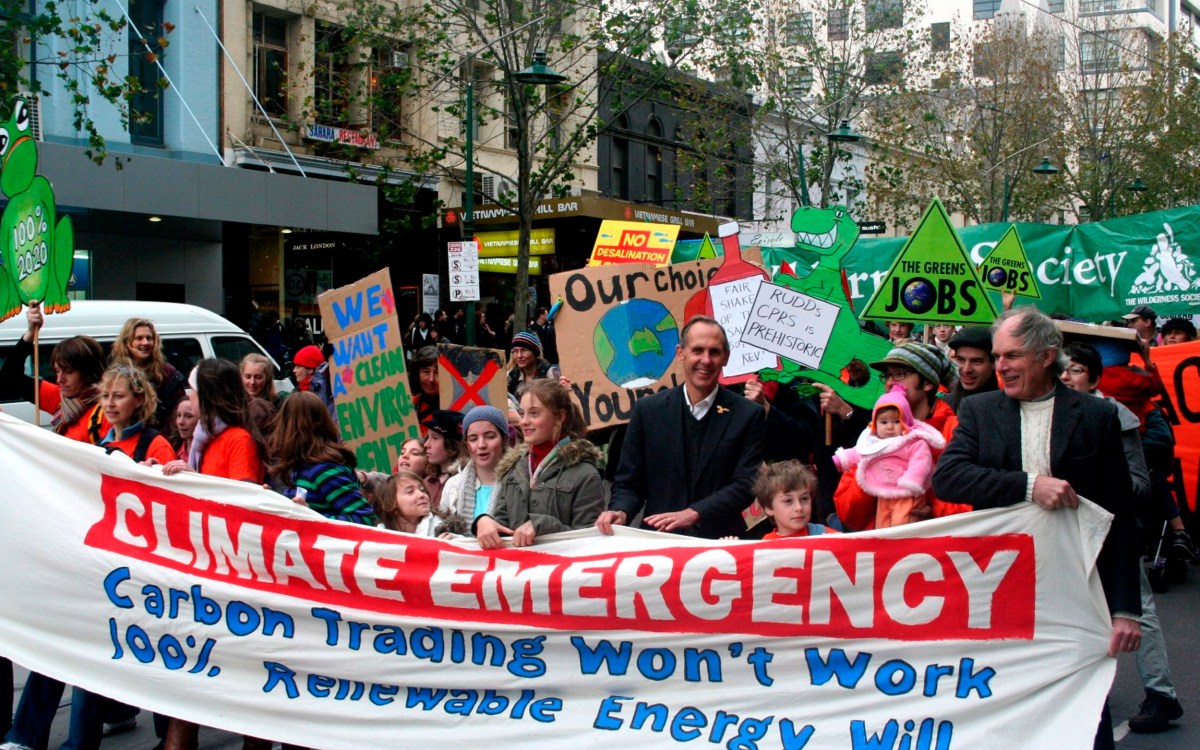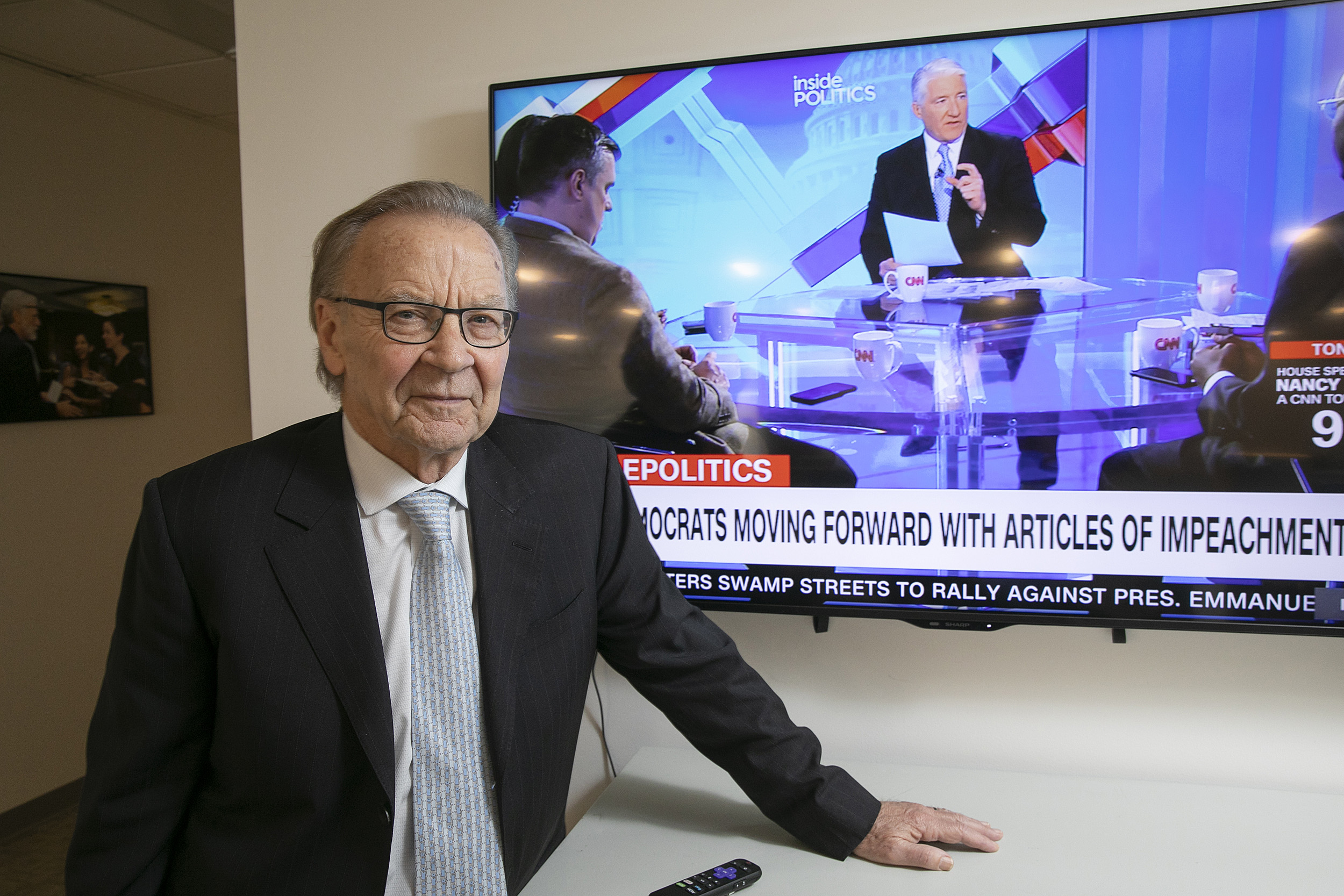
Thomas Patterson’s new book tackles the misinformation epidemic.
Jon Chase/Harvard Staff Photographer
Flight from reason
Thomas Patterson looks at the threat to Democracy in ‘How America Lost Its Mind’
The following is excerpted from the new book “How America Lost Its Mind: The Assault on Reason That’s Crippling Our Democracy” by Thomas E. Patterson. He is the Bradlee Professor of Government & the Press at Harvard University’s Kennedy School.
It was a bright Sunday afternoon in the nation’s capital when Edgar Maddison Welch walked into Comet Ping Pong and, after telling customers to flee, searched the pizzeria and opened fire with an assault rifle. Why? Welch had driven his truck from North Carolina to “self-investigate” a story he had seen online. The fake story claimed that coded emails on Hillary Clinton’s private server revealed the shop was a front for a child sex ring in which she and other top Democrats were involved. The victims were supposedly imprisoned below the restaurant. Whatever fool Welch might have been, he was not alone in his thinking. A poll taken after Welch’s arrest indicated that a third of American adults thought the sex ring allegation was “definitely” or “probably” true.
Absurd ideas are nothing new. When fluoride was added to the nation’s water supply six decades ago, some Americans said it was a communist plot to poison the nation’s youth. Fear of communism soon led to other bizarre ideas, including the claim that President Eisenhower and Martin Luther King were Soviet agents. In a seminal 1964 Harper’s Magazine article, the historian Richard Hofstadter described such thinking as “the paranoid style.” “No other word,” Hofstadter wrote, “adequately evokes the sense of heated exaggeration, suspiciousness, and conspiratorial fantasy that I have in mind.”
The crazed anti-communists of the Cold War era have met their match in recent years. Nearly every major political development has sparked fanciful claims, even when the facts are right before our eyes. On Sept. 11, 2001, Americans saw airliners plow into the World Trade Center towers and the Pentagon. Within days, they saw footage of the terrorists going through security lines at Boston’s Logan Airport and heard that they had flight training in Florida and Arizona. Nevertheless, conspiracy theorists claim it was an inside job orchestrated by the U.S. government, with the airliners said to be on autopilot. And rather than collapsing from intense heat, the towers were brought to earth by explosive devices triggered by government agents.
If 9/11 sparked some of the more farfetched conspiracy theories, one doesn’t have to search hard to find others. They number in the scores and have one thing in common — the belief that powerful actors secretly plotted a foul deed and are getting away with it. And it is nearly impossible to convince theorists that they are wrong. The logic of a conspiracy theory is its own defense. Powerful actors who are clever enough to pull off an evil deed are clever enough to cover their tracks with a plausible lie.
Some conspiracy theories are harmful. A few are downright dangerous. Most are merely bizarre. More harmful to our democracy is a cousin of conspiracy theories — misinformation. It also involves fanciful ideas about the actual state of the world, but it is far more widespread and a far greater threat. At times, it describes the thinking of a majority, as it did during the lead-up to the 2003 Iraq invasion. Polls showed that most Americans falsely believed that Iraq was aligned with al-Qaeda, the terrorist group behind the 9/11 attacks — many even falsely believed Iraqis were actually flying the planes. Those with false beliefs were four times more likely than better-informed Americans to favor an invasion of Iraq.
A plane approaches New York’s World Trade Center moments before it struck the tower at left, as seen from downtown Brooklyn, Tuesday, Sept. 11, 2001.
AP Photo/ William Kratzke

Some degree of political misinformation is to be expected. Politics is largely a secondhand experience — something we hear about from others. But today’s volume of misinformation is unprecedented. Some beliefs are so far off the mark as to raise doubts about our reasoning ability.
Ironically, the misinformed think they’re highly informed. “Cognoscenti of their own bamboozlement” is how sociologist Todd Gitlin describes them. A study found, for example, that those who know the least about climate-change science are the ones who think they’re the best informed on the issue. Another study found that those who are the least knowledgeable about welfare benefits are the ones who claim to know the most about it.
A full list of Americans’ false beliefs would fill many pages. Here are some of the more prominent ones from recent years, along with the rough percentage of Americans who believed they were true at the time the poll was taken:
Donald Trump won the popular vote in the 2016 election (20 percent).
Iraqis used weapons of mass destruction against U.S. troops during the Iraq invasion (20 percent).
The 2010 Affordable Care Act includes “death panels” (40 percent).
Childhood vaccines cause autism (15 percent).
Barack Obama was definitely or probably born outside the United States (30 percent).
Global warming is a hoax (35 percent).
Russia didn’t meddle in the 2016 presidential election (37 percent).
Early scientific opinion polls revealed that Americans didn’t know much about public affairs. An alarming number of citizens couldn’t answer simple questions like the name of their state’s governor. Analysts questioned whether citizens were equipped to play the role that democracy asks of them.
Since then, there has been a revolution in mass communication and a leap in the number of people with college educations. Americans have never had so much information available or been better trained to handle it. Yet they are no better informed today than they were decades ago. The high-school-educated public of the 1950s knew as much about the structure of America’s government as does the media-saturated, college-educated public of today. When asked in a recent national survey to name the three branches of government, only a third of respondents could do so. Another third could name one or two. The final third couldn’t name a single one. Those ratios are nearly the same as when Americans were asked the question in 1952.
“Some conspiracy theories are harmful. A few are downright dangerous. Most are merely bizarre. More harmful to our democracy is a cousin of conspiracy theories — misinformation. It also involves fanciful ideas about the actual state of the world, but it is far more widespread and a far greater threat.”
Duke University’s James David Barber wrote that the uninformed “are dangerously unready when the time comes for choice.” But whatever risk the uninformed pose, it pales alongside the risk posed by the misinformed. The uninformed know what they don’t know, whereas the misinformed think they know something but don’t know it. It is the difference between ignorance and irrationality.
Add to that the problem of anxiety. It is raging in today’s America, and it can play tricks on the mind. The American Psychological Association conducts a yearly survey of Americans’ level of stress over issues such as work and money. In the most recent survey, 80 percent of respondents reported a symptom of stress during the past month, such as feeling overwhelmed or depressed. Two-thirds of respondents expressed anxiety over the country’s future.
We don’t have to look hard for reasons. The middle class has shrunk, despite the fact that dual-income households are now the norm. The manufacturing sector with its high-paying union jobs has shrunk while the service sector, with its lower wages and smaller benefits, has mushroomed. Mechanized farming, smaller families, and flight to the cities have hollowed out many of our rural communities.
When anxiety is high, people look for someone or something to blame for why things are not going well. Their identification with those who share their plight strengthens, as does their belief that other people are the cause of their problem. If that belief is dismissed by outsiders, it heightens their sense of injustice. It becomes easier to accept the notion that immigrants are the major cause of low wages or that free trade is the main reason for the loss of factory jobs, although neither belief is factually correct.
The need to cast blame outweighs the urge to discover the truth. In “Thinking Fast and Slow,” Nobel laureate Daniel Kahneman demonstrates that people are not driven by a desire for accuracy. What they seek instead are explanations that meet their psychological needs. We have, says Kahneman, an “almost unlimited ability to ignore our ignorance.”
Better-educated citizens would like to believe that misinformation is a problem of the less educated. That is generally true. Psychologists have found that individuals with weakly developed cognitive skills suffer from an inflated sense of what they know. Nevertheless, when it comes to misinformation on more complicated issues, the better educated are often the most misinformed. How can that be? It’s known as the “smart idiot effect.” On more complicated subjects, better-educated individuals with strong opinions find it easier to come up with reasons that support their thinking. Better-educated Republicans, for example, are more likely than other Republicans to believe that the theory of climate change is a hoax.
Changes in communication have fueled the rise in misinformation. The traditional guardians of information — our journalists, educators, and scientists — have been losing authority while less-reliable sources — our talk show hosts, bloggers, and ideologues — have been gaining our loyalty. At the same time, faster modes of communication have supplanted slower ones.
With the Internet, crackpots don’t need the news media to spread their nonsense. The Comet Ping Pong allegation started on the Internet and then was propelled by fake news sites and amplified by Twitter bots based in eastern Europe. Within a few weeks, the claim was widely known.
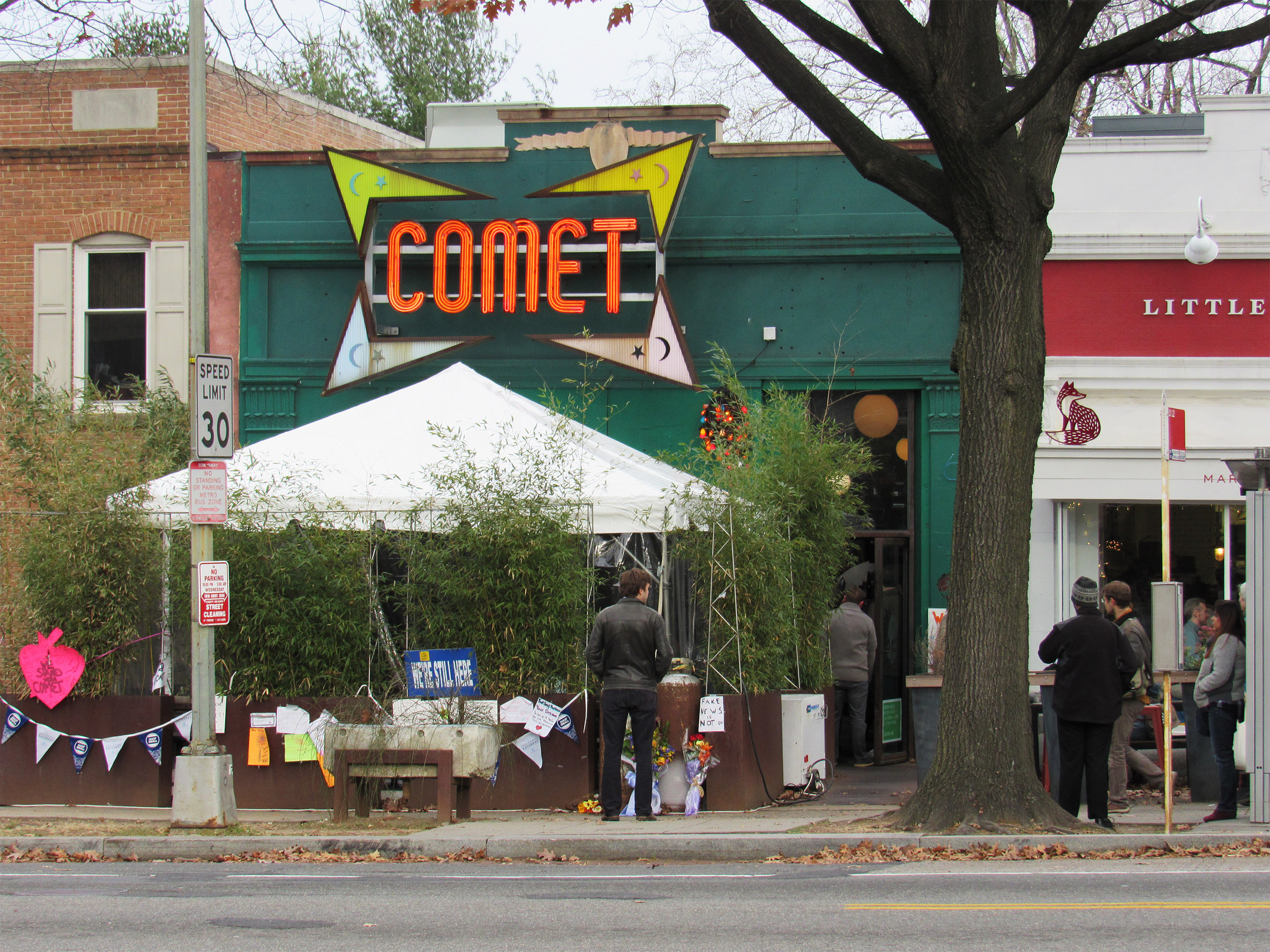
Comet Ping Pong pizza shop in Northwest Washington, D.C.
Wikimedia Commons
Although collective ignorance on the scale of recent years is rare, the casual way in which Americans arrive at their opinions is altogether ordinary. We are far too busy and the world is far too complex to be traversed without mental shortcuts — what the mathematician George Zipf called the “principle of least effort.” We routinely take shortcuts, as when we follow a store owner’s advice on which coffee maker to buy rather than consulting Consumer Reports.
When it comes to politics, party loyalty is the typical shortcut. But undeniable facts can override party loyalty. Opposition to sending U.S. troops to the Middle East increased among Republicans and Democrats alike as the human and financial costs of America’s involvement in the region soared. But when the issue is less clear-cut, party loyalty is typically our guide. In 2015, Republicans had a more favorable view of free trade agreements than did Democrats. Nearly 60 percent of Republicans said that the agreements were good for the country. By 2017, with a Republican president opposed to free trade, Republicans had switched sides on the issue; less than 40 percent now felt that it benefited the country.
Partisan bias is a powerful psychological defense. During the 2016 presidential election, Donald Trump was heard saying on “Access Hollywood” tapes that he groped women at will. Trump’s opponents saw his behavior as sexual abuse. Trump’s supporters accepted his explanation — “locker room talk.” When more than a dozen women then came forward to accuse Trump of sexual impropriety, the vast majority of non-Trump voters said they believed what the women were saying. However, most of Trump’s supporters said the women were lying, and most of the rest said they weren’t sure whether to believe them. Only one in 10 said the women’s claims were credible.
Scholars use the term “confirmation bias” — our tendency to interpret information in ways that support our preexisting beliefs — to explain such responses. Confirmation bias causes us to respond selectively to information in a way that reinforces what we want to believe. In one study, supporters and opponents of capital punishment were provided two studies, one of which made the case for the death penalty while the other made the case against it. Participants’ opinions were then retested. Those initially in favor of the death penalty were now more strongly in favor of it while those initially opposed were now more firmly opposed.
On most issues, the misinformed are concentrated in one party or the other. They have greater reason to jigger the facts. As the rumor spread that Hillary Clinton was part of a child sex ring run out of a pizza shop, Republicans were far more likely than Democrats to think it was true. After 9/11, when it was rumored that George W. Bush knew in advance of the terrorist attack and chose to let it happen to further his geopolitical ambitions, Democrats were far more likely than Republicans to believe it.
“As party differences have increased, so have the political stakes. And as the stakes go up, so does the skullduggery.”
Political parties have been around since George Washington’s administration, when policy disagreements between Thomas Jefferson and Alexander Hamilton led them to form opposing parties. But if parties are old, why is misinformation suddenly so prevalent? What changes in the parties could account for the recent surge?
Party polarization is one. Over the past several decades, the parties have been moving apart, such that there is barely an issue today on which they see eye-to-eye. Over the past few decades, the gap between Republicans and Democrats on legalized abortion has increased by a factor of five. On the question of human-caused climate change, the gap is now nine times greater. In terms of a ban on assault weapons, the divide has tripled.
The divide in Congress is even wider. By the 112th Congress (2011–12), the middle had been hollowed out. As measured by roll-call votes, the least conservative Republican in the House or Senate was more conservative than the most conservative Democrat. Four decades earlier, roughly a fourth of House and Senate members were out of step with their party’s majority — more conservative in the case of Democrats and more liberal in the case of Republicans.
As party differences have increased, so have the political stakes. And as the stakes go up, so does the skullduggery. In 2009, Betsy McCaughey, the former lieutenant governor of New York, falsely claimed on a conservative talk show that the health care reform bill under debate in Congress “would make it mandatory that every five years people in Medicare have a required counseling session that will tell them how to end their life sooner.” From there, McCaughey’s allegation snaked from one right-wing talk show to the next, buoyed by passionate op-eds she wrote for the Wall Street Journal and New York Post. Talk show host Glenn Beck called the legislation “euthanasia.”
Although supporters of the health care bill pointed out that it didn’t contain a death panel provision, Republican leaders stuck to the fictional version. House Republican leader John Boehner put out a statement saying, “This provision may start us down a treacherous path toward government-encouraged euthanasia if enacted into law.” And as the GOP attack escalated, the death panels allegation spilled over to the mainstream media and quickly lodged itself in people’s minds. A Pew Research Center poll found that six of every seven adult Americans were aware of the claim. Of those familiar with it, half said it was true or probably true. Two out of every three Republicans accepted the possibility.
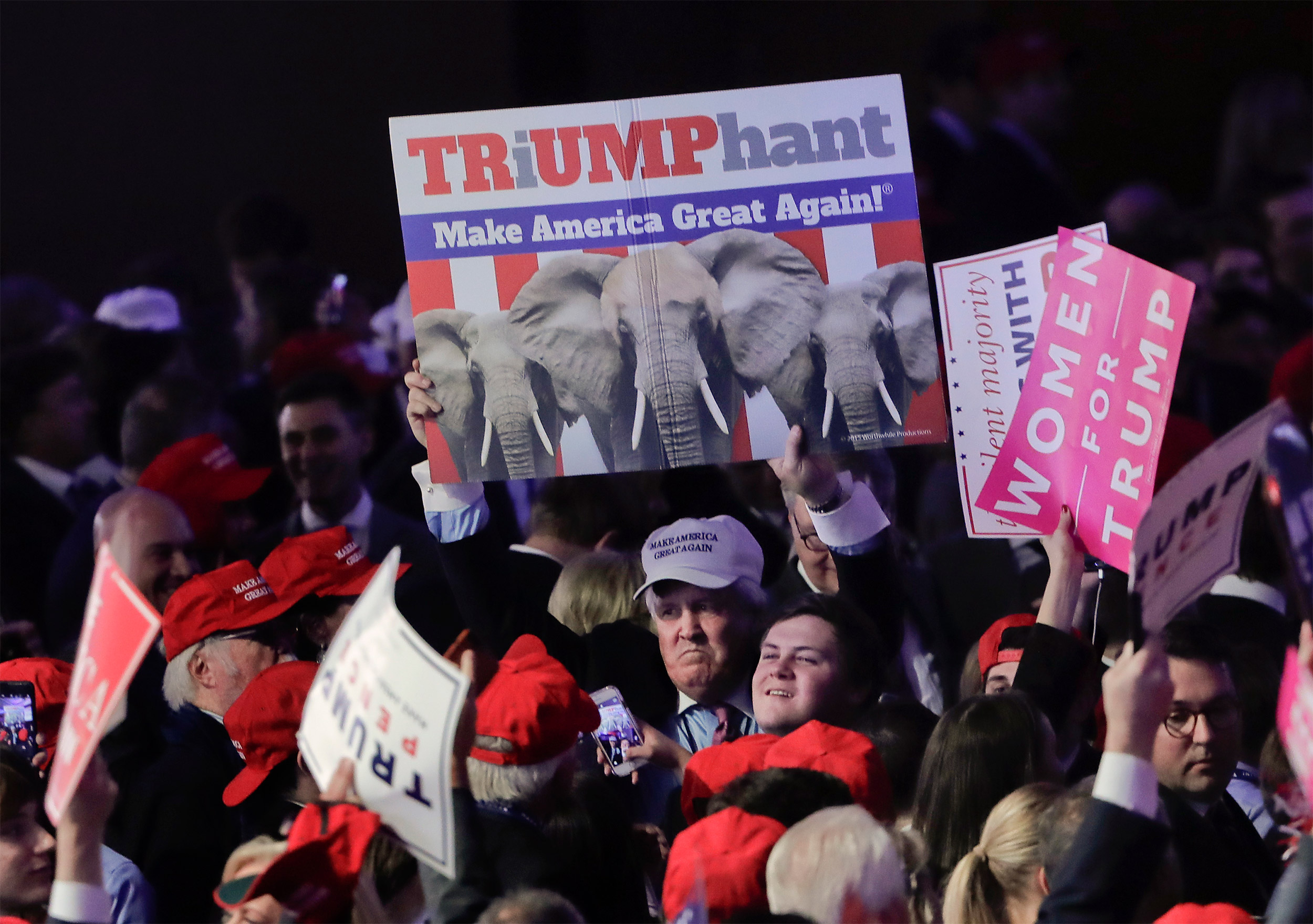
Donald Trump supporters react to election night results during a rally in New York.
AP Photo/Julie Jacobson
A few decades ago, lawmakers had a harder time playing tricks on the American people. The presence in Congress of conservative Democrats and liberal Republicans meant there would be vigorous dissent if cheap ploys were attempted. A false claim loses traction when partisans hear lawmakers of their own party say it’s phony.
The public is at fault, too. They recognize that much of what politicians say is self-serving. But messages don’t arrive with a warning sign or seal of approval that would allow people to separate fact from fiction. And studies indicate that most citizens are not very good at distinguishing between the two. It doesn’t help that we are in a post-truth age where alternative realities are being peddled at every turn. We have slipped into a time when facts are increasingly what people would like them to be
Political elites bear much of the blame for the recent sharp rise in misinformation. Many of them are more than willing to employ false claims if it gives them an edge. A 2015 study found that misinformation is highest for issues “on which elites prominently and persistently [make] incorrect claims.” If only a few people are misinformed on an issue, it could be dismissed as the work of oddballs. It takes a gang to hoodwink a nation.
Misinformation on the scale of recent years is unprecedented. And it couldn’t have happened without help from the news media. Rather than take responsibility for the facts, journalists strive for “balance” — giving each side a chance to make its case. It’s a sensible approach in many situations and protects journalists from accusations of bias. Yet the approach breaks down when one side is making things up. Balanced reporting then devolves into what the Atlantic’s James Fallows calls “false equivalencies” — the side-by-side presentation of statements that differ wildly in their factual integrity. When a politician tells a bold-faced lie, and the press reports it, the press is complicit in the deception; the claim gets publicized and gains credibility from appearing in the news.
Is it possible to institutionalize misinformation? Are there ways through policy to entrench it? In 1987, the Federal Communication Commission (FCC) unwittingly did so. It revoked the “fairness doctrine.” That policy discouraged the airing of partisan talk shows by requiring stations to offer a balanced lineup of liberal and conservative programs. After it was gone hundreds of radio stations shifted to partisan talk shows, most of which had a conservative slant. Within a few years, the highest-rated program, “The Rush Limbaugh Show,” hosted by a former radio shock jock, had millions of weekly listeners.
“The Internet is an extraordinary advance. It has changed our lives in positive ways, giving us a level of access to information that was unimaginable a few decades ago. Yet mixed in with the Internet’s reliable content is misinformation, so many shades of it that it would put a lipstick counter to shame.”
Limbaugh’s success led Rupert Murdoch to start Fox News. To run it, he hired Republican political consultant Roger Ailes, who scheduled partisan talk shows in prime time. Other cable outlets followed with prime-time shows of their own. The combined radio and television partisan talk show audience now exceeds 50 million weekly listeners.
On some of these programs, listeners are fed a distorted version of truth. To sell it, hosts claim to be wiser than just about anyone. Others lie, they say, but I will give you the truth. Facts are not to be trusted, they say, unless you hear them from me. Limbaugh told his listeners to stop following traditional news outlets. “I’ll let you know what they’re up to,” he said. Rachel Maddow prefaces many of her attacks with “This is not personal,” implying that it’s truth rather than her opinion that the viewer is about to hear. When Trump launched cruise missiles in response to Syria’s use of chemical weapons, Maddow’s “This is not personal” claim was that Trump was trying to divert attention from the investigation into Russian meddling in the 2016 election. “Even if the tail is wagging the dog,” she said, “even if this decision was taken with absolutely no regard for whatever else is going on in the President’s life right now [it] unavoidably creates a real perception around the globe that, that may have been a part of the motivation.”
Partisan talk show hosts traffic in outrage, seeking to convince their listeners that the other party is hell-bent on destroying America. On that score, there is not much difference between conservative and liberal hosts. Sarah Sobieraj, coauthor of “The Outrage Industry,” notes that “their political ideologies are different, but the way they speak, the types of images they use, their techniques of belittling people, of name calling, of character assassination, are similar.”
The Internet is an extraordinary advance. It has changed our lives in positive ways, giving us a level of access to information that was unimaginable a few decades ago. Yet mixed in with the Internet’s reliable content is misinformation, so many shades of it that it would put a lipstick counter to shame.
The Internet allows anyone with the time and interest to be a reporter, editor, and publisher, as well as a self-declared expert. Every second of every day, someone is pumping misinformation into the Internet, out of carelessness, stupidity, greed, or malice. Outrage is a big draw, getting far more shares and “likes” than does reasoned argument. The result is a flood of misinformation, much of it presented with the self-righteousness of a Sadducee.
Every wacky idea imaginable can be found on the Internet. You probably weren’t aware that Sen. Mitch McConnell funneled Russian cash to Donald Trump or that Edward Snowden was part of a years-long Russian plot to torpedo Hillary Clinton’s presidential ambitions or that Andrew Breitbart was murdered by Vladimir Putin in order to put Steve Bannon in charge of Breitbart News. Well, it’s all there on the Internet, located on sites operated by extreme left-wingers.
Donald Trump (left) and Russian President Vladimir Putin shake hands at the beginning of a meeting at the Presidential Palace in Helsinki, Finland.
AP Photo/Pablo Martinez Monsivais

The alt-right has even a larger presence on the Web. Until the major social media platforms shut it down, Alex Jones’s “InfoWars” was among the most prominent of the alt-right outlets. Jones claimed the massacre of 26 children and teachers at Connecticut’s Sandy Hook Elementary School in 2012 was faked. When 17 students and staff members were murdered in 2018 in the shooting at Marjory Stoneman Douglas High School in Parkland, Fla., Jones called one of the surviving students, David Hogg, a “crisis actor” — a term used for individuals who get paid to pretend to be disaster victims. Hogg had advocated for gun control, which Jones opposes. A video claiming Hogg was a crisis actor reached the top spot on YouTube’s trending page.
Breitbart News draws roughly 75 million monthly visitors. Even at its peak, the John Birch Society, the top alt-right outlet of its day, had fewer than 100,000 members. One of the wilder ideas perpetrated by the Birchers was the claim that a “one-world government” was being promoted by a shadowy group of conspirators, many of them holding powerful positions in Washington. Other than the Birchers, few Americans took the claim seriously. The notion got new life a few years ago when Breitbart began promoting it. Today, a third of Americans think it’s true.
Online exposure to the like-minded reinforces people’s beliefs and gives them a false sense of how much they know. There’s something about the process of accessing information online that leads people to think that they are suddenly a lot smarter. A Yale University study found that “people who search for information on the Web emerge from the process with an inflated sense of how much they know.”
“Buyer beware” signs should also be posted on social media. It’s not simply that social media contain a staggering amount of misinformation. We tend to believe much of it because it is forwarded by friends and acquaintances. Just as familiar claims are more likely to be believed, claims that come from people we know are more likely to be seen as true.
“Aside from the delusional comfort it offers, misinformation doesn’t have much to recommend it. But there’s arguably something worse: people who know they are being fed false information and embrace it.”
One of the biggest dangers of misinformation is that the odds of unintended consequences increase when misinformation is clustered in the minds of loyalists of one party or the other, which is the normal pattern. If misinformation was randomly distributed across the electorate, it would be a nuisance. But when it’s concentrated among one party’s loyalists, the odds increase that their side will make a policy decision that makes society worse off, exemplified by Republicans’ “voodoo economics” in the 1980s. Instead of providing the promised increase in tax revenue, it delivered an exploding federal deficit and an accelerated path to income inequality.
The concentration of misinformation within one party is also a barrier to policy negotiation. When Republican and Democratic lawmakers agree on the facts, they can negotiate their differences. It becomes harder when they can’t agree on the facts. As the late Sen. Daniel Patrick Moynihan once complained when negotiation over a bill broke down, “Everyone is entitled to his own opinion but not to his own facts.” Facts do not settle arguments, but they’re a necessary starting point. Recent debates on everything from foreign policy to climate change have fractured or sputtered because of factual disagreements.
Aside from the delusional comfort it offers, misinformation doesn’t have much to recommend it. But there’s arguably something worse: people who know they are being fed false information and embrace it.
It’s impossible to know how many of Donald Trump’s diehard supporters are of this type, but Trump makes too many false statements for his backers to accept everything he says as gospel. In an assessment of Trump’s pronouncements during his first two years as president, The Washington Post tallied over 7,000 false or misleading claims — an average of 10 a day. They started with his claim that his inaugural crowd, which photos showed to be relatively sparse, was record breaking. “The audience was the biggest ever,” Trump said. “This crowd was massive.” When polls showed his approval rating dropping, Trump tweeted, “Any negative polls are fake news.”
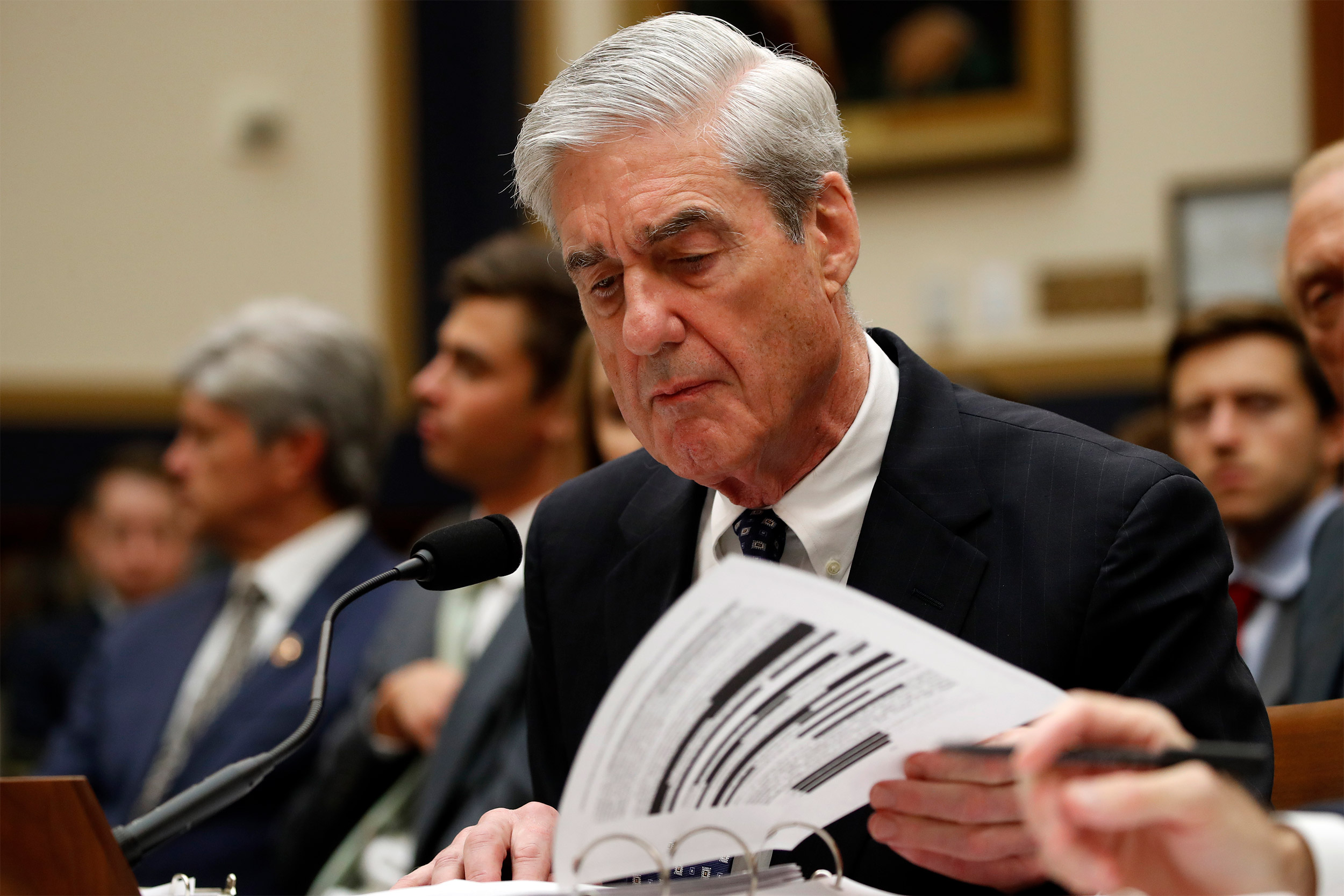
Former special counsel Robert Mueller checks pages in the report as he testifies before the House Judiciary Committee hearing on his report on Russian election interference.
AP Photo/Alex Brandon
Why do Trump’s fabrications work? The answer speaks to a troubling feature of American politics — the distrust that Americans feel toward politicians. It is so deep that many have changed their test of lying. Authenticity, not factual accuracy, is their yardstick. Was Trump ever going to build “a big, beautiful border wall as high as 55 feet” and “have Mexico pay for it”? The chances are remote. A literal reading of Trump’s claim misses the point. It was his way of saying he’d be tough on immigration. That’s what many Americans were seeking and, in Trump, they thought they had finally found a politician who would stick to his word.
Trump has another tendency, one shared by many politicians. It’s the tendency to portray policy problems as having simple explanations and easy solutions. During the 2016 presidential campaign, Trump and Bernie Sanders took aim at free trade. Trump said he would “kill” NAFTA and called the recently negotiated Trans-Pacific Partnership the “rape of our country.” Sanders said, “With the passing of each free trade agreement, we see a decline in good-paying manufacturing jobs as well as the destruction of many communities.” Neither candidate was giving voters the full story. Foreign trade has indeed resulted in a loss of factory jobs, but it is not anywhere near the leading job killer. It accounts for only one in eight lost factory jobs. Automation is the real killer. Since the 1950s, manufacturing has shed two-thirds of its jobs, but output has increased sixfold because of automation. And the problem will only get worse as advances in artificial intelligence enable machines to take over more jobs.
Americans’ flight into fantasy has tilted our politics in favor of politicians who indulge our capacity for wishful thinking. Sanders claimed that a vote for him would fix health care, the costs of college, and a host of other problems, notwithstanding that his proposals had virtually no chance of getting through Congress. For his part, Trump is the expert of everything. “I have a gut,” he said, “and my gut tells me more sometimes than anybody else’s brain can ever tell me.”
America’s misinformation crisis thus runs deeper than a bunch of errant thoughts banging around in people’s heads. As The New York Times’s David Brooks said, there has been “a breakdown in America’s ability to face evidence objectively, to pay due respect to reality, to deal with complex and unpleasant truths. Once a country tolerates dishonesty, incuriosity and intellectual laziness, then everything else falls apart.” Decades ago, the philosopher Hannah Arendt drew a darker lesson, saying that the rise of demagogues is abetted by “people for whom the distinction between fact and fiction, true and false, no longer exists.”
Have we been here before? Has America ever been plagued by so much magical thinking? The 1850s — the heyday of the “Know Nothings” — is arguably the closest period.
The immigration of millions of Catholics from Ireland and Germany beginning in the 1830s had put Protestant America on edge, sparking the Know Nothing movement. It was driven by a belief that the newly arrived immigrants were conspiring with Rome to take over America and put the pope in charge. The movement had outspoken leaders but was organized as a secret society. If asked about it, members were told to say “I know nothing.” They had all sorts of cockeyed beliefs, including the notion that the Irish were a racially separate and inferior group.
In the mid-1850s, the Know Nothings had a burst of electoral success, sweeping a statewide election in Massachusetts, winning a number of mayoral races, including those in San Francisco and Philadelphia, and nominating a presidential candidate who finished third in the balloting. But they were out of business before the 1850s ended. Their governing policies were as zany as their theories.
Outrageous ideas abound today but, unlike those of the Know Nothings, they are not likely to disappear in short order. The conditions necessary for misinformation to thrive are firmly in place, held there by three of America’s sturdiest anchors — the lust for money, the lure of celebrity, and the drive for power.
Excerpted from “How America Lost Its Mind: The Assault on Reason That’s Crippling Our Democracy” by Thomas E. Patterson, published by the University of Oklahoma Press, October 2019. Excerpt used with permission.



